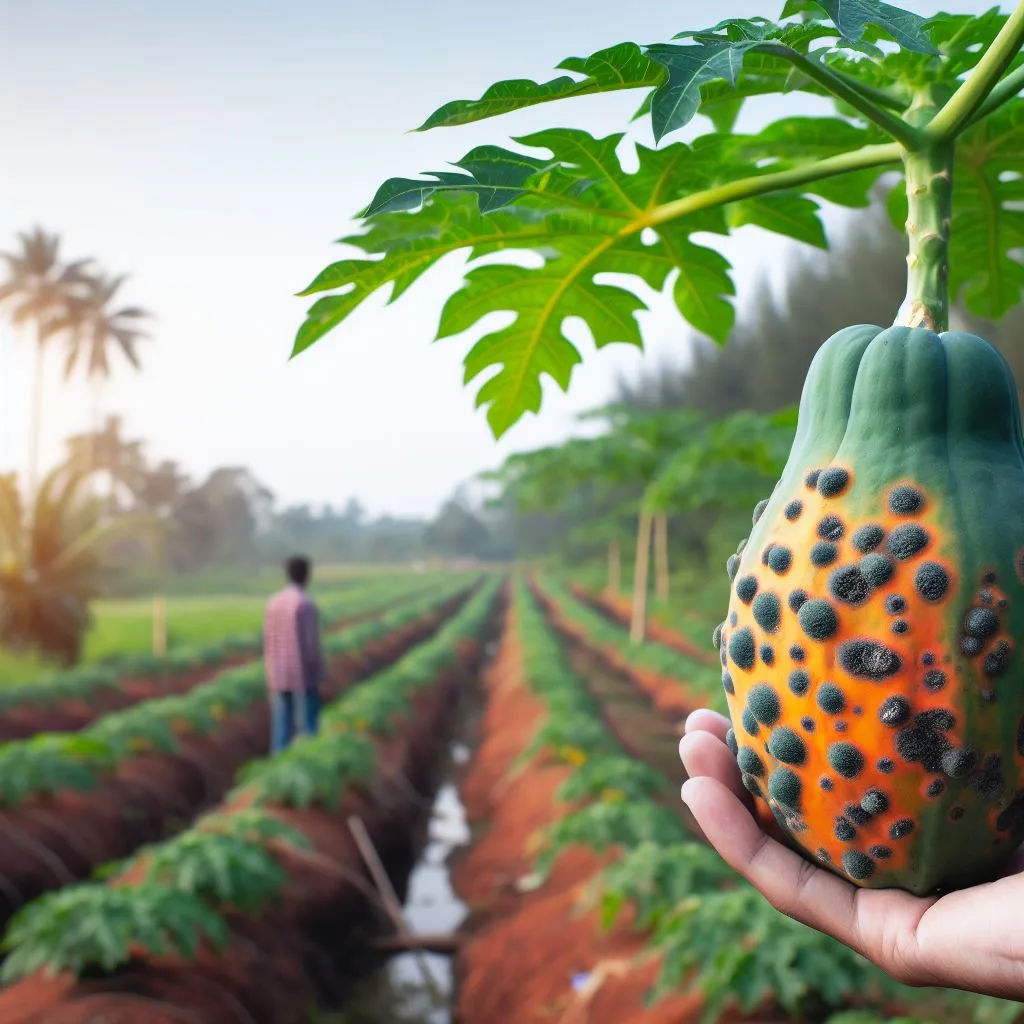
As a farmer or gardening enthusiast, the allure of growing papaya trees is undeniable. These tropical wonders not only provide a delectable fruit but also add a touch of exotic beauty to any landscape. However, the journey of cultivating papaya trees is not without its challenges, as these plants are susceptible to various diseases that can hinder their growth and productivity. In this comprehensive guide, we will delve into the world of papaya tree diseases, exploring the causes, symptoms, and effective solutions to combat these afflictions. By understanding the intricacies of papaya tree diseases, you can safeguard your precious plants and ensure a thriving harvest.
Common Causes of Papaya Tree Diseases
Papaya tree diseases can stem from a multitude of factors, with environmental conditions playing a pivotal role in their onset. One of the primary causes is poor soil drainage, which can lead to waterlogged roots and create an ideal breeding ground for pathogens. Additionally, inadequate sunlight exposure and improper air circulation can weaken the papaya tree’s natural defenses, making it more susceptible to diseases. Furthermore, the use of contaminated tools and equipment during pruning and maintenance activities can introduce harmful microorganisms to the plants, exacerbating the risk of infections.
Moreover, nutrient deficiencies, particularly in essential elements such as nitrogen, potassium, and magnesium, can compromise the papaya tree’s immune system, rendering it more prone to diseases. It is also crucial to be mindful of the surrounding vegetation, as certain plant species may harbor pests and pathogens that can easily transfer to papaya trees. By thoroughly understanding these common causes, you can proactively implement preventive measures to fortify your papaya trees against potential diseases.
Recognizing the Symptoms of Papaya Tree Diseases
Effectively managing papaya tree diseases begins with the ability to recognize the telltale signs of affliction. One of the most prevalent symptoms is the appearance of unusual spots or lesions on the leaves, which can vary in color and texture depending on the specific disease. These blemishes may be accompanied by wilting, yellowing, or distortion of the foliage, indicating an underlying health issue. Furthermore, stunted growth, premature fruit drop, and abnormal fruit development are indicative of systemic problems within the papaya tree.
In some cases, the presence of pests and their associated damage can serve as a precursor to disease manifestation. It is essential to closely monitor the overall vitality of the papaya tree, including the resilience of its stems and the condition of its root system. By keenly observing these symptoms, you can promptly intervene and administer targeted treatments to alleviate the impact of diseases on your papaya trees.
Detailed Analysis of Specific Papaya Tree Diseases
Powdery Mildew
Powdery mildew is a common fungal disease that afflicts papaya trees, characterized by a white powdery coating on the leaves and stems. This disease thrives in humid environments and may lead to leaf distortion and reduced photosynthetic capacity. To mitigate powdery mildew, it is advisable to improve air circulation around the plants and employ organic fungicidal sprays.
Anthracnose
Anthracnose is another prevalent papaya tree disease caused by Colletotrichum gloeosporioides, resulting in dark, sunken lesions on the fruits and foliage. Implementing proper sanitation practices and utilizing copper-based fungicides can effectively manage anthracnose and prevent its spread.
Phytophthora Fruit Rot
Phytophthora fruit rot, caused by Phytophthora palmivora, manifests as water-soaked lesions on the papaya fruits, eventually leading to their decay. Enhancing soil drainage and avoiding overwatering can aid in preventing this destructive disease from affecting your papaya trees.
Prevention Measures for Papaya Tree Diseases
In the quest to safeguard papaya trees from diseases, proactive prevention measures serve as the first line of defense. Implementing proper sanitation practices, such as sterilizing pruning tools and removing fallen debris, can significantly reduce the risk of disease transmission. Furthermore, maintaining optimal soil drainage and ensuring adequate sunlight exposure are crucial for fostering a healthy growing environment for papaya trees. Regular soil testing and balanced fertilization can also fortify the trees against nutrient deficiencies, bolstering their resilience to diseases.
Introducing beneficial companion plants that repel pests and pathogens can further enhance the protective barrier around papaya trees. Additionally, practicing crop rotation and intercropping with compatible species can disrupt the life cycles of potential pests and diseases, minimizing their impact on the papaya orchard. By diligently adhering to these prevention measures, you can create a fortified ecosystem that mitigates the risk of papaya tree diseases.
Solutions to Combat Papaya Tree Diseases
When faced with the onset of papaya tree diseases, it is essential to deploy effective solutions to mitigate their impact and restore the plants to health. Organic treatments, such as neem oil and potassium bicarbonate-based fungicides, offer environmentally friendly options for managing fungal infections and pest infestations. Pruning affected branches and removing diseased fruits can limit the spread of diseases and promote the rejuvenation of the papaya trees.
For bacterial diseases, copper-based sprays and biocontrol agents containing beneficial microorganisms can aid in suppressing the pathogens and revitalizing the plant’s natural defenses. It is imperative to adhere to proper application protocols and dosage recommendations to maximize the efficacy of these solutions. By integrating these targeted treatments, you can combat papaya tree diseases while upholding the integrity of the surrounding ecosystem.
Case Studies: Successful Management of Papaya Tree Diseases
Case Study 1: Integrated Pest Management
In a commercial papaya orchard, the implementation of integrated pest management strategies led to a significant reduction in disease incidence. By incorporating natural predators and beneficial insects, the orchard effectively controlled pest populations, curbing the spread of diseases and minimizing the need for chemical interventions.
Case Study 2: Soil Health Optimization
Through comprehensive soil analysis and tailored nutrient management, a small-scale papaya farm achieved remarkable resilience against common diseases. By addressing specific soil deficiencies and enhancing microbial diversity, the farm was able to foster robust papaya trees that exhibited heightened resistance to diseases and sustained productivity.
Expert Tips for Maintaining Healthy Papaya Trees
Tip 1: Regular Monitoring
Frequent monitoring of papaya trees allows for early detection of diseases and pests, enabling timely interventions to preserve the plant’s health.
Tip 2: Balanced Nutrition
Ensuring a well-balanced nutrient regimen tailored to the specific requirements of papaya trees is essential for bolstering their immune system and resilience to diseases.
Tip 3: Prudent Watering Practices
Adopting controlled watering practices that prevent waterlogging and maintain optimal soil moisture levels is critical for preventing root diseases in papaya trees.
Resources for Further Information about Papaya Tree Diseases
For additional insights and in-depth knowledge about papaya tree diseases, the following resources can serve as valuable references:
- Papaya Diseases and Their Management – University of Florida
- Integrated Pest Management for Papaya – University of Hawaii
- Papaya Pest and Disease Management – Food and Agriculture Organization of the United Nations
Conclusion: Overcoming the Challenge of Papaya Tree Diseases
In the realm of papaya cultivation, the threat of diseases looms as a formidable obstacle, yet with proper understanding and proactive measures, it is possible to conquer this challenge. By identifying the causes, recognizing the symptoms, and implementing targeted solutions, you can safeguard your papaya trees and nurture a thriving orchard. With a commitment to proactive prevention, diligent monitoring, and informed management practices, you can elevate the health and productivity of your papaya trees, ensuring a bountiful harvest for years to come.
Unveiling the Mystery of Papaya Tree Diseases: Causes, Symptoms, and Solutions aims to equip you with the knowledge and strategies needed to navigate the intricate landscape of papaya tree diseases. Embrace the journey of cultivating resilient papaya trees, and witness the flourishing beauty of these tropical marvels in your own orchard.







